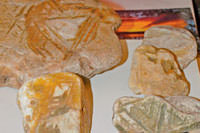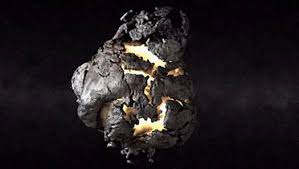The Tunguska event, or Tunguska blast or Tunguska explosion, was an enormously powerful explosion that occurred near the Tunguska River in Russia, at about 7:14 a.m. KRAT (0:14 UT) on June 30 1908.
The explosion is believed to have been caused by the air burst of a large meteroid or comet fragment at an altitude of 5–10 kilometres (3–6 miles) above the Earth's surface. Different studies have yielded varying estimates of the object's size, with general agreement that it was a few tens of metres across.
The number of scholarly publications on the problem of the Tunguska explosion since 1908 may be estimated at about 1,000 (mainly in Russian). At around 7:17 a.m. local time, Tungus natives and Russian settlers in the hills northwest of Lake Baikal observed a column of bluish light, nearly as bright as the Sun , moving across the sky. About 10 minutes later, there was a flash and a sound similar to artillery fire. Eyewitnesses closer to the explosion reported the sound source moving east to north. The sounds were accompanied by a shock wave that knocked people off their feet and broke windows hundreds of kilometres away. The majority of witnesses reported only the sounds and the tremors, and not the sighting of the explosion. Eyewitness accounts differ as to the sequence of events and their overall duration.
The explosion registered on Seismic stations across Eurasia. In some places the shock wave would have been
- Testimony of S. Semenov, as recorded by Leonid Kulik's expedition in 1930.
At breakfast time I was sitting by the house at Vanavara Trading Post [65 kilometres/40 miles south of the explosion], facing north. I suddenly saw that directly to the north, over Onkoul's Tunguska Road, the sky split in two and fire appeared high and wide over the forest . The split in the sky grew larger, and the entire northern side was covered with fire. At that moment I became so hot that I couldn't bear it, as if my shirt was on fire; from the northern side, where the fire was, came strong heat. I wanted to tear off my shirt and throw it down, but then the sky shut closed, and a strong thump sounded, and I was thrown a few metres. I lost my senses for a moment, but then my wife ran out and led me to the house. After that such noise came, as if rocks were falling or cannons were firing, the earth shook, and when I was on the ground, I pressed my head down, fearing rocks would smash it. When the sky opened up, hot wind raced between the houses, like from cannons, which left traces in the ground like pathways, and it damaged some crops. Later we saw that many windows were shattered, and in the barn a part of the iron lock snapped.
DID UFO'S SAVE US ? The mystery of the Tunguska meteorite disaster is still unveiled. Something enormous exploded in the area of the Podkamennaya Tunguska River in Russia’s Siberia on . The square of the destruction area can be compared to the size of the city of Moscow today. However, there was nothing found on the site of the disaster: no traces of the impact and no debris of the space body.
Scientists believe that the extraterrestrial body that exploded in the Tunguska area was a stony meteorite that blew up and evaporated completely in the Earth’s atmosphere.Events similar to the Tunguska catastrophe may occur every 500 or 1,000 years. Therefore, there are chances to find traces of several other mammoth catastrophes in the Antarctic ice core, scientists believe.A Russian scientist claims that aliens downed the Tunguska meteorite 101 years ago to protect our planet from devastation. Yuri Lavbin says he found unusual quartz crystals at the site of the massive Siberian explosion. Ten crystals have holes in them, placed so the stones can be united in a chain, and other have drawings on them. “We don’t have any technologies that can print such kind of drawings on crystals,” said Lavbin. “We also found ferrum silicate that can not be produced anywhere, except in space.”
A couple of expeditions have gone to the remote site of the crash. Lavbin says that one expedition located the unusual crystals.
While I’m not a chemist, I couldn’t find any information on “ferrum silicate.” Seemingly, it doesn’t exist.This isn’t the first time a UFO has been claimed to associated with the Tunguska event. Another report from 2004 said a scientific expedition to the site found blocks of an extraterrestrial technical device, and one 50-kilogram piece of the stone was brought to the city of Krasnoyarsk to be studied and analyzed. No subsequent reports or analysis could be located during an internet search.
Other claims of exploding alien spaceships or alien weapons detonating to “save the Earth from an imminent threat” appear to originate from a science fiction story “A Visitor From Outer Space” written by Soviet engineer Alexander Kazantsev in 1946, in which a nuclear-powered Martian spaceship, seeking fresh water from a lake blew up in mid-air. This story was was said to be inspired by Kazantsev’s visit t
Hiroshima in late 1945.

The behaviour of meteorites in the Earth's atmosphere was less well understood during the early decades of the 20th century. Due to this, as well as the paucity of relevant data resulting from Soviet secrecy during the Cold War , a great many other hypotheses for the Tunguska event have sprung up, none of which are accepted by the scientific community.







0 comments:
Post a Comment